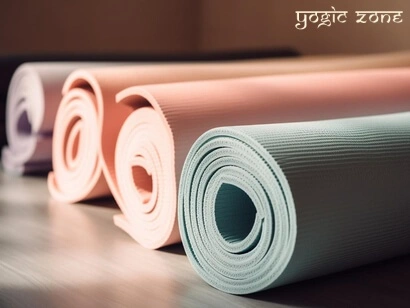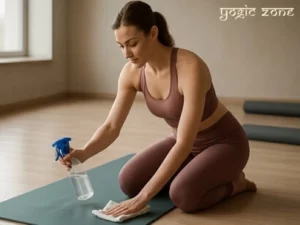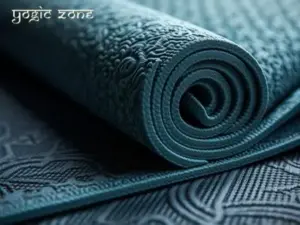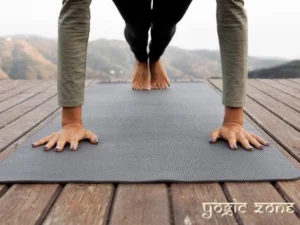
Yoga specialist and an independent yoga teacher | Advanced Teacher Training Course – 900 Hours TTC | Ashtanga Vinyasa Yoga 200 Hours. Know more about Sanhita Joshi.
For beginners, understanding the different types of yoga mats and buying the right one can be a challenge. As a yoga instructor, I have seen how the right mat surface can improve stability, comfort, and focus.
It is often confusing to understand what different mat materials such as PVC, TPE, rubber, cotton, or cork actually mean and how they affect your practice. In this guide, I will help you explore the popular types of yoga mats, yoga mat materials, and their important features.
Types of Yoga Mats—At a Glance
| Type | Best For | Pros | Cons | |
|---|---|---|---|---|
| 1 | PVC Yoga Mats | General home practice, beginners on a budget | Durable, sticky grip, easy to clean, very affordable | Not eco-friendly, chemical smell when new |
| 2 | TPE Yoga Mats | Beginners wanting comfort + eco-conscious choice | Lightweight, recyclable, soft texture, good grip | Less durable than PVC, grip may reduce with sweat |
| 3 | Natural Rubber Mats | Vinyasa, Ashtanga, sweaty or dynamic styles | Excellent grip, cushioning, biodegradable, eco-friendly | Heavier, natural rubber scent, more expensive |
| 4 | Cotton Yoga Mats | Gentle yoga, meditation, traditional Indian styles | Breathable, absorbent, washable, can layer over other mats | Minimal grip and cushioning on smooth floors |
| 5 | Cork Yoga Mats | Hot yoga, eco-conscious practitioners | Antimicrobial, improves grip with moisture, firm and supportive | Less cushioning, may feel slippery when dry |
1. PVC Yoga Mats
PVC mats are made of polyvinyl chloride and are common in yoga classes and home practice. They offer strong grip and durability at an affordable price, which makes them a practical starting choice for beginners. However, they are not the most eco-friendly option and may have a slight smell when new.
My students generally ask me:
“Why do I always slip on my yoga mat?”
You might be using a worn-out or cheap PVC mat. Try wiping it with a damp cloth before practice, or use a thin yoga towel for added grip. Read our blog on the ultimate guide to yoga mat cleaning.

2. TPE Yoga Mats
TPE (thermoplastic elastomer) mats offer a balance between comfort and sustainability. They are soft, lightweight, and recyclable, making them ideal for home practitioners or travellers. However, they can lose grip if you sweat heavily.
My answers to some frequently asked questions:
- “Are foldable yoga mats good, or do they crease?”
Foldable TPE mats are great for travel. Just avoid folding them sharply; gentle rolling keeps them in good shape. - “Is a travel yoga mat too thin for daily practice?”
Travel mats are best for short sessions or on-the-go practice. For daily use, choose medium thickness (5–6 mm).
3. Natural Rubber Yoga Mats
Rubber mats, made from tree rubber, are ideal for practitioners who prioritise performance and durability. They provide a firm base with excellent traction, even in sweaty conditions—ideal for Ashtanga or Vinyasa styles. They are heavier and costlier but last long and are fully biodegradable.
My students generally ask me:
“Which is the best mat for high-intensity Vinyasa or power yoga?”
A natural rubber mat provides superior grip and stable cushioning for active, sweat-heavy styles.
Do you have any doubts or questions about this article?? I am Sanhita Joshi, the author, and I would love to hear from you. Send us your question now!
Cork Yoga Mats: Natural & Antimicrobial
Cork mats come with a natural cork top surface and a TPE or rubber base. They improve grip as you sweat and stay naturally antimicrobial, making them hygienic for regular use.
My answers to some frequently asked questions:
- “Do cork mats get more grippy when wet?”
Yes, cork becomes slightly more textured with moisture, improving grip during hot or sweaty sessions. - “Are towel-top mats worth it for sweaty sessions?“
Yes, towel-top mats or adding a microfiber yoga towel can help absorb sweat and prevent slipping. - “What is the best non-slip mat for hot yoga?”
Cork or natural rubber mats perform best under heat and sweat, offering consistent grip.
4. Cotton Yoga Mats: Traditional & Breathable
Cotton yoga mats are a popular choice due to their lightweight and skin-friendly surface. Cotton mats are often used in classical yoga settings and are perfect for gentle practice. Many yogis use them as a comfortable, absorbent top layer over another mat.
How to Choose the Right Type of Yoga Mats for You
With so many different types of yoga mats, how does one decide? According to me, the choice depends on your practice style, comfort needs, and personal values.
- For hot yoga: Cork or rubber mats offer traction when sweaty.
- For home practice: TPE or PVC mats work well and are easier to maintain.
- For travel: Choose foldable or lightweight TPE mats that can fit in a bag.
There’s no single best yoga mat for everyone. By understanding the different types of yoga mats, you can make an informed choice that will support you on your yoga journey. Consider reading our article What to Look for in a Yoga Mat.
Do you have any doubts or questions about this article?? I am Sanhita Joshi, the author, and I would love to hear from you. Send us your question now!
Frequently Asked Questions About Types of Yoga Mats
How do I choose the right yoga mat thickness for my practice?
Thicker mats (6–8 mm) are better for knee and joint support, while thinner mats (3–4 mm) give better stability and grounding for balancing poses. Choose based on comfort vs. stability needs.
What material is best for a yoga mat if my hands get sweaty?
Look for mats made of natural rubber, PU-coated surfaces, or cork. These offer a strong grip even when wet and prevent slipping during practice.
Is a cork yoga mat good for beginners?
Yes. Cork mats are naturally non-slip and feel sturdy and grounded. They work especially well if you sweat and prefer a firm surface rather than a cushioned one.
Are eco-friendly yoga mats durable enough for daily use?
High-quality natural rubber, jute, and cork mats are durable and long-lasting. Just keep them away from direct sunlight and heat to maintain elasticity and texture.
Should I choose a textured or smooth yoga mat surface?
Textured surfaces prevent slipping, especially for dynamic flows or hot yoga. Smooth surfaces feel softer and are comfortable for slower, gentler practices.
Do expensive yoga mats really make a difference?
Higher-quality mats offer better grip, longevity, eco-friendly materials, and body support. If you practice regularly, investing in a good mat can improve comfort and safety.
I mostly do stretching and yin—do I need a special mat?
A cotton or thick TPE mat works best for slower, restorative, or yin styles.



